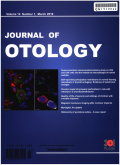- 钛学术文献服务平台 \
- 学术期刊 \
- 医药卫生期刊 \
- 五官科学期刊 \
- 中华耳科学杂志(英文版)期刊 \
Bell's palsy workup: Does audiometry add value?
Bell's palsy workup: Does audiometry add value?
基本信息来源于合作网站,原文需代理用户跳转至来源网站获取
摘要:
Objective: To investigate if routine audiometry in Bell's palsy patients has prognostic value.Methods: Retrospective case review was conducted on all Bell's palsy patients (n=191) seen at the ter-tiary otolaryngology specialist outpatient clinic from 2015 to 2017. Correlation of ipsilesional audiometric thresholds with patients' time-to-recovery and initial clinical severity (measured by House-Brackmann (HB) scoring) were used for the prognostic outcome measure. Audiometry results were analyzed using three contiguous frequency pure-tone average (1kHz, 2kHz, 4kHz). Statistical analysis was done via Stata (v13.1), significance tests were 2-sided at 5% significance level. Results: There was no significant difference between audiometric thresholds between the ipsilesional ear and the contralateral ear (p=0.87). Time-to-recovery was significantly longer for patients with severe initial presentation as compared to mild and moderate severity (p<0.01). There was no correlation found between the audiometry results and HB score at presentation (p=0.39). There was no correlation found between ipsilesional audiometric thresholds and time-to-recovery (p=0.58). Conclusion: Our study suggests that routine audiometry has limited prognostic value in Bell's palsy patients.

推荐文章
Bell's面瘫的中医护理
辨证施护
情志护理
面瘫
瞬目反射和面神经电图在Bell's麻痹中的应用
Bell's麻痹
瞬目反射
面神经电图
随机ADD算法的不确定网络优化研究
网络优化
加速对偶梯度下降算法
随机ADD
收敛速率
基于Bell态纠缠交换的身份认证协议
量子身份认证
纠缠交换
Bell基测量
内容分析
关键词云
关键词热度
相关文献总数
(/次)
(/年)
文献信息
| 篇名 | Bell's palsy workup: Does audiometry add value? | ||
| 来源期刊 | 中华耳科学杂志(英文版) | 学科 | |
| 关键词 | |||
| 年,卷(期) | 2021,(2) | 所属期刊栏目 | Research Articles |
| 研究方向 | 页码范围 | 61-64 | |
| 页数 | 4页 | 分类号 | |
| 字数 | 语种 | 英文 | |
| DOI | |||
五维指标
引文网络
引文网络
二级参考文献 (0)
共引文献 (0)
参考文献 (13)
节点文献
引证文献 (0)
同被引文献 (0)
二级引证文献 (0)
1900(1)
- 参考文献(1)
- 二级参考文献(0)
1982(2)
- 参考文献(2)
- 二级参考文献(0)
1983(1)
- 参考文献(1)
- 二级参考文献(0)
1990(1)
- 参考文献(1)
- 二级参考文献(0)
1996(1)
- 参考文献(1)
- 二级参考文献(0)
2000(1)
- 参考文献(1)
- 二级参考文献(0)
2002(2)
- 参考文献(2)
- 二级参考文献(0)
2007(1)
- 参考文献(1)
- 二级参考文献(0)
2012(1)
- 参考文献(1)
- 二级参考文献(0)
2013(1)
- 参考文献(1)
- 二级参考文献(0)
2015(1)
- 参考文献(1)
- 二级参考文献(0)
2021(0)
- 参考文献(0)
- 二级参考文献(0)
- 引证文献(0)
- 二级引证文献(0)
引文网络交叉学科
相关学者/机构
期刊影响力
中华耳科学杂志(英文版)
主办单位:
解放军总医院耳鼻咽喉科研究所
出版周期:
季刊
ISSN:
1672-2930
CN:
11-4883/R
开本:
出版地:
北京市复兴路28号
邮发代号:
创刊时间:
语种:
eng
出版文献量(篇)
450
总下载数(次)
0
期刊文献
相关文献
推荐文献
- 期刊分类
- 期刊(年)
- 期刊(期)
- 期刊推荐

 免费查重
免费查重










